Unreal Tournament 3 CPU & High End GPU Analysis: Next-Gen Gaming Explored
by Anand Lal Shimpi & Derek Wilson on October 17, 2007 3:35 AM EST- Posted in
- GPUs
High End GPU Performance
While a few titles based on the Unreal Engine 3 have already made their way onto the scene, the detail and atmosphere of Unreal Tournament 3 really show off what developers can do with this engine if they take the time to understand it. Between its first party titles and Bioshock, Epic certainly makes a solid statement that its Unreal Engine 3 is an excellent choice for leading edge graphics.
For this test, we are looking at performance scaling on high end video cards ($300+) across multiple resolutions and on multiple maps. We will absolutely be revisiting this game with midrange hardware and multiGPU configurations. In this analysis, we focus on the performance of the Suspense capture the flag map flyby. This is the most graphically intense flyby we have, and the other two maps we tested tended to exhibit similar relative performance between cards.
With our high end hardware, we've pulled out the 1920 x 1200 tests, as this is very likely to be the resolution paired with one of these parts.
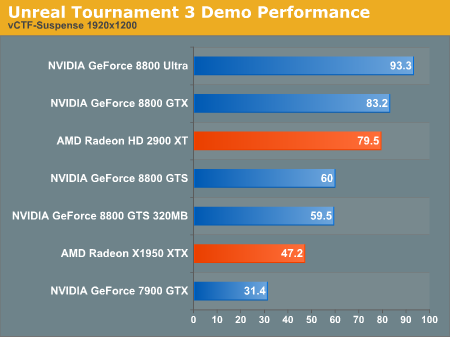
The NVIDIA GeForce 8800 GTX and Ultra both outperform the AMD Radeon HD 2900 XT, which is to be expected: the 2900 XT costs much less. But the performance gap here is not huge, and the 2900 XT gets major points for that. It handily outperforms its direct competition, the 8800 GTS (both 640MB and 320MB perform nearly identically). Not surprisingly, the X1950 XTX bests the 7900 GTX, and both of these parts perform worse than the 8800 GTS cards.
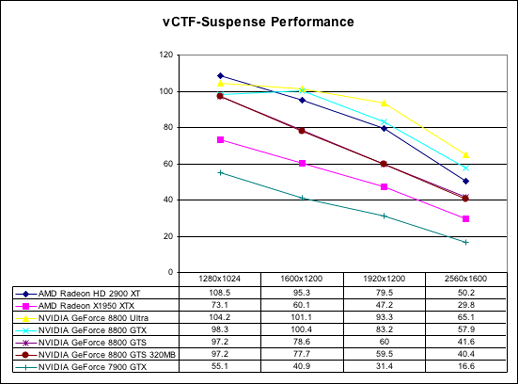
If we look at the scaling graph for Suspense, we can see that the GTS cards remain above 40fps even at 2560x1600. This is quite impressive, especially for the low memory GTS, but we do have to keep in mind that this is a flyby in a demo version of the game and we may see changes in performance between now and the final version.
Also intriguing is the fact that the high end NVIDIA hardware seems to become CPU limited at less than 1600x1200. This leads to the fact that AMD's Radeon HD 2900 XT actually outperforms the 8800 Ultra at 1280x1024. The 8800 Ultra does seem to scale very well with resolution, while the 7900 GTX drops off quickly and under performs through out the test.
While the rest of this data is very similar to what we've already presented, we did go to the trouble of running the numbers. In order to present a complete picture of what we've seen on the less demanding levels, here is the rest of our data:
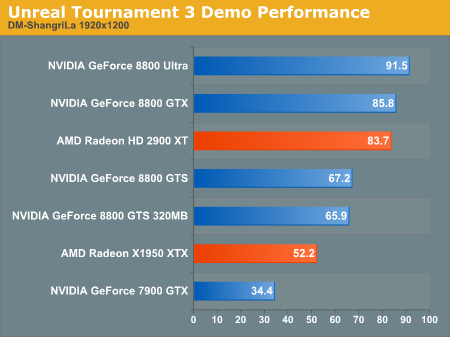
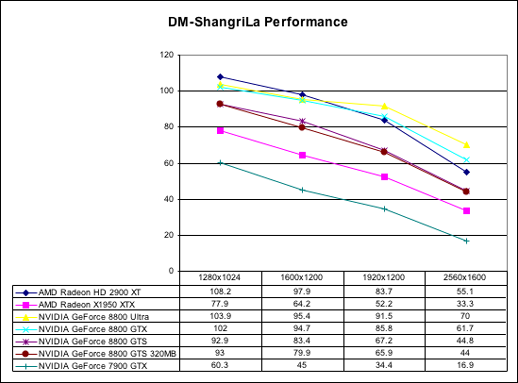
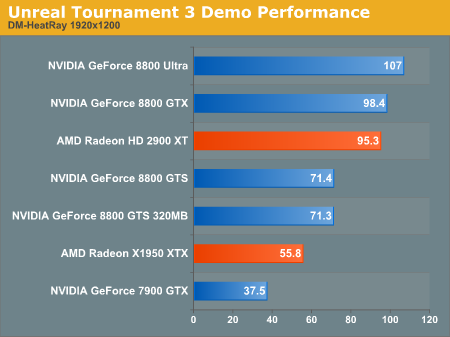
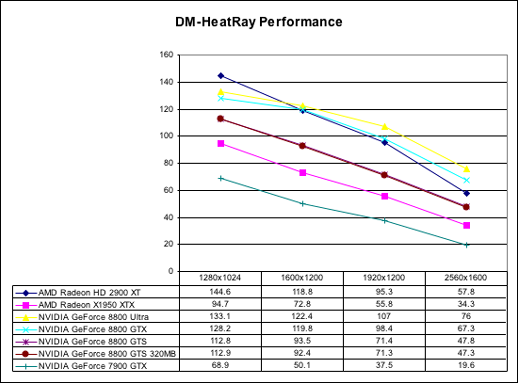
Final Words
We're just getting started with our UT3 performance analysis, but already there are some interesting conclusions to be had. Quite possibly the biggest takeaway from this comparison is the dramatic improvement in multi-threaded game development over the past couple of years. Starting from a point where none of our game benchmarks were multi-threaded just two years ago, here we are today with the latest and greatest from Epic, and seeing huge gains from one to two cores, and promising improvements when moving to four cores.
Quad-core gaming is still years away from being relevant (much less a requirement), but the industry has come a tremendous distance in an honestly very short period of time. We're more likely to have multi-threaded games these days than 64-bit versions of those titles, mostly thanks to the multi-core architecture in both the Xbox 360 and PlayStation 3. Like it or not, but much of PC gaming development is being driven by consoles, the numbers are simply higher on that side of the fence (even though the games themselves look better on this side).
On the GPU side, NVIDIA of course does quite well with the 8800 lineup, but the real surprise is how competitive AMD is with the Radeon HD 2900 XT. There may be some salvage yet for that architecture, if AMD could only bring out a midrange part that actually offered compelling performance...










72 Comments
View All Comments
Super Nade - Wednesday, October 17, 2007 - link
Hi,A very interesting article. I was wondering if you could pit Intel and AMD chips having the same L2 cache against each other? You can clock up the lower specced Intel part if need be. Since the game is L2 bound, this experiment would provide a more balanced outlook in a GPU bound or a clock-for-clock situation.
Cheers,
S-N
OCForums
johnsonx - Wednesday, October 17, 2007 - link
If this is a beta demo (the multiplayer server browser does scream BETA! doesn't it?), does anyone know if there will be an updated 'final' demo? Further, will there be any Onslaught maps in said demo?gramboh - Wednesday, October 17, 2007 - link
Does AA work in the demo? I've downloaded it but due to Orange Box I haven't even bothered installing it.I'm mainly interested to know if the 8800GTS/GTX blow away the 2900XT or not once AA is enabled at 1920x1200 so that I feel better about my purchase of a 8800GTS 640 :)
NullSubroutine - Wednesday, October 17, 2007 - link
I dont think the purpose of reviews is to make you feel better about what you already bought. But hey, to each his own.jamori - Wednesday, October 17, 2007 - link
I appreciated the inclusion of some of the previous-gen cards here. Some of the recent graphics card reviews completely left them out, which essentially leaves me guessing as to how much improvement I might see by upgrading my graphics card.30 fps at 1920x1200 on my 7900GTX isn't great, but it's still at the lower threshold of playable, which is nice to know.
p30n - Wednesday, October 17, 2007 - link
What does this show us? At least for UT3 quad (vs dual) is rather a waste. If it shows so small and increase when its not gpu limited (ie low res 1024 tests) one wonders what will happen at higher res where the gpu is actually pressured.And even more so when your already crossing 100fps does it even matter?
Now if quad helped us go from say 20 fps to 30fps I would say hell yeah its actually making a difference, but as is 155 fps to 186 fps...omg now I have to get a quad!
Of course there were no tests at high res to compare core effect too.
RamarC - Wednesday, October 17, 2007 - link
You have to remember that these were flybys with no activity. UT3 is making little of use of the extra cores now, but I'll bet that a quad core will flex its muscle once you add players, vehicles, explosions, and all the mayhem that goes along with a good UT match.jebo - Wednesday, October 17, 2007 - link
I thought the CPU tests were interesting, but largely useless! It reminds me of the UT2K3 flyby vs botmatch days. Why didn't Derek and Anand use Fraps to run a few botmatches. Sure the results aren't 100% repeatable, but if you run a couple botmatches on each setup and average the fps you'd get a fairly accurate result.Anand Lal Shimpi - Wednesday, October 17, 2007 - link
I actually played with this, the frame rates weren't actually much different at all. You also have to keep in mind that in real world usage there won't be any bots, just other human opponents.Take care,
Anand
DerekWilson - Wednesday, October 17, 2007 - link
just to underline this, running through a level with fraps yielded very similar framerates to the flyby tests.but the problem here is that even our run throughs were not very taxing. We can't add 9 thousands bots to a game and test anything, as they will cause problems with the run through adding variability and removing the possibility of repeatability.
we don't have a doezen people we can start up a multiplayer game with and choreograph a scene that we can run every time we need another number.
the real solution to the issue is the demo record and playback functionality. until we get that, flyby testing is the best we can offer and just isn't any better than a fraps run.